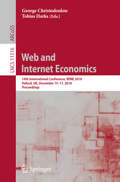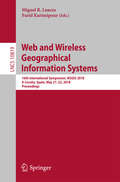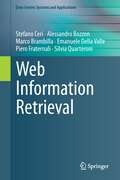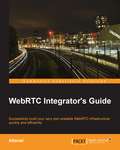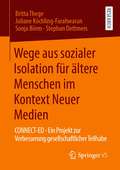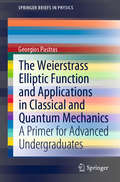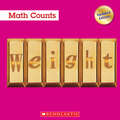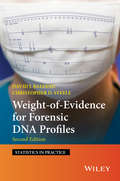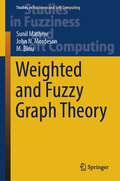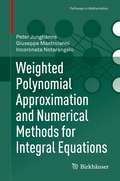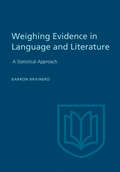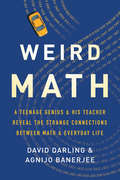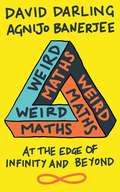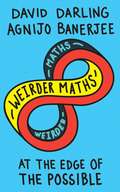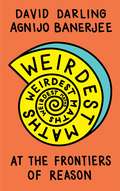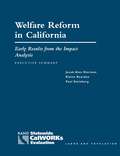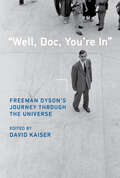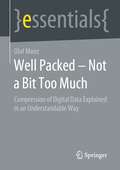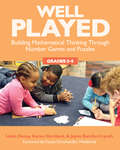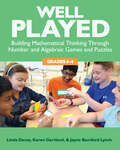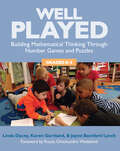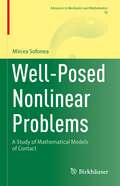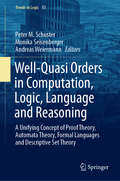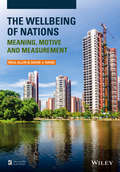- Table View
- List View
Web and Internet Economics: 14th International Conference, WINE 2018, Oxford, UK, December 15–17, 2018, Proceedings (Lecture Notes in Computer Science #11316)
by George Christodoulou Tobias HarksThis book constitutes the thoroughly refereed proceedings of the 14th International Conference on Web and Internet Economics, WINE 2018, held in Oxford, UK, in December 2018. The 28 full papers presented were carefully reviewed and selected from 119 submissions. The papers reflect the work of researchers in theoretical computer science, artificial intelligence, and microeconomics who have joined forces to tackle problems at the intersection of computation, game theory and economics.
Web and Wireless Geographical Information Systems: 16th International Symposium, W2GIS 2018, A Coruña, Spain, May 21–22, 2018, Proceedings (Lecture Notes in Computer Science #10819)
by Miguel R. Luaces Farid KarimipourThis book constitutes the refereed proceedings of the 16th International Symposium on Web and Wireless Geographical Information Systems, W2GIS 2018, held in A Coruña, Spain, in May 2018. The 15 full papers included in the volume were carefully reviewed and selected from 20 submissions. They deal with theoretical, technical, and practical issues in the field of wireless and Internet technologies suited for the dissemination, usage, and processing of geo-referenced data.
Web Information Retrieval
by Emanuele Della Valle Marco Brambilla Piero Fraternali Alessandro Bozzon Stefano Ceri Silvia QuarteroniWith the proliferation of huge amounts of (heterogeneous) data on the Web, the importance of information retrieval (IR) has grown considerably over the last few years. Big players in the computer industry, such as Google, Microsoft and Yahoo!, are the primary contributors of technology for fast access to Web-based information; and searching capabilities are now integrated into most information systems, ranging from business management software and customer relationship systems to social networks and mobile phone applications. Ceri and his co-authors aim at taking their readers from the foundations of modern information retrieval to the most advanced challenges of Web IR. To this end, their book is divided into three parts. The first part addresses the principles of IR and provides a systematic and compact description of basic information retrieval techniques (including binary, vector space and probabilistic models as well as natural language search processing) before focusing on its application to the Web. Part two addresses the foundational aspects of Web IR by discussing the general architecture of search engines (with a focus on the crawling and indexing processes), describing link analysis methods (specifically Page Rank and HITS), addressing recommendation and diversification, and finally presenting advertising in search (the main source of revenues for search engines). The third and final part describes advanced aspects of Web search, each chapter providing a self-contained, up-to-date survey on current Web research directions. Topics in this part include meta-search and multi-domain search, semantic search, search in the context of multimedia data, and crowd search. The book is ideally suited to courses on information retrieval, as it covers all Web-independent foundational aspects. Its presentation is self-contained and does not require prior background knowledge. It can also be used in the context of classic courses on data management, allowing the instructor to cover both structured and unstructured data in various formats. Its classroom use is facilitated by a set of slides, which can be downloaded from www.search-computing.org.
WebRTC Integrator's Guide
by Altanai AltanaiThis book is for programmers who want to learn about real-time communication and utilize the full potential of WebRTC. It is assumed that you have working knowledge of setting up a basic telecom infrastructure as well as basic programming and scripting knowledge.
Wege aus sozialer Isolation für ältere Menschen im Kontext Neuer Medien: CONNECT-ED - Ein Projekt zur Verbesserung gesellschaftlicher Teilhabe
by Britta Thege Juliane Köchling-Farahwaran Sonja Börm Stephan DettmersDas Buch stellt das Begegnungskonzept CONNECT-ED aus der Praxis der Altenarbeit zur Vermittlung von Medienkompetenz vor und präsentiert empirische Daten zur sozialen Teilhabe und Lebensqualität der Teilnehmenden. Die Forschungsergebnisse zeigen Potenziale des Internets für ältere Menschen auf und eröffnen Perspektiven für geschlechts- und alterssensible Weiterbildungsangebote.
The Weierstrass Elliptic Function and Applications in Classical and Quantum Mechanics: A Primer for Advanced Undergraduates (SpringerBriefs in Physics)
by Georgios PastrasThe field of elliptic functions, apart from its own mathematical beauty, has many applications in physics in a variety of topics, such as string theory or integrable systems. This book, which focuses on the Weierstrass theory of elliptic functions, aims at senior undergraduate and junior graduate students in physics or applied mathematics. Supplemented by problems and solutions, it provides a fast, but thorough introduction to the mathematical theory and presents some important applications in classical and quantum mechanics. Elementary applications, such as the simple pendulum, help the readers develop physical intuition on the behavior of the Weierstrass elliptic and related functions, whereas more Interesting and advanced examples, like the n=1 Lamé problem-a periodic potential with an exactly solvable band structure, are also presented.
Weight (Math Counts: Updated Editions)
by Henry PluckroseAn introduction to capacity for the youngest readers!Math Counts series introduces young readers (grades K-3) to early math concepts. Real-world examples and corresponding photos make math concepts easy to grasp.Weight is a measuring word. We weigh things to find out how heavy they are.
Weight-of-Evidence for Forensic DNA Profiles (Statistics in Practice #34)
by David J. Balding Christopher D. SteeleDNA evidence is widely used in the modern justice system. Statistical methodology plays a key role in ensuring that this evidence is collected, interpreted, analysed and presented correctly. This book is a guide to assessing DNA evidence and presenting that evidence in a courtroom setting. It offers practical guidance to forensic scientists with little dependence on mathematical ability, and provides the scientist with the understanding they require to apply the methods in their work. Since the publication of the first edition of this book in 2005 there have been many incremental changes, and one dramatic change which is the emergence of low template DNA (LTDNA) profiles. This second edition is edited and expanded to cover the basics of LTDNA technology. The author's own open-source R code likeLTD is described and used for worked examples in the book. Commercial and free software are also covered.
Weighted and Fuzzy Graph Theory (Studies in Fuzziness and Soft Computing #429)
by Sunil Mathew John N. Mordeson M. BinuOne of the most preeminent ways of applying mathematics in real-world scenario modeling involves graph theory. A graph can be undirected or directed depending on whether the pairwise relationships among objects are symmetric or not. Nevertheless, in many real-world situations, representing a set of complex relational objects as directed or undirected is not su¢ cient. Weighted graphs o§er a framework that helps to over come certain conceptual limitations. We show using the concept of an isomorphism that weighted graphs have a natural connection to fuzzy graphs. As we show in the book, this allows results to be carried back and forth between weighted graphs and fuzzy graphs. This idea is in keeping with the important paper by Klement and Mesiar that shows that many families of fuzzy sets are lattice isomorphic to each other. We also outline the important work of Head and Weinberger that show how results from ordinary mathematics can be carried over to fuzzy mathematics. We focus on the concepts connectivity, degree sequences and saturation, and intervals and gates in weighted graphs.
Weighted Polynomial Approximation and Numerical Methods for Integral Equations (Pathways in Mathematics)
by Peter Junghanns Giuseppe Mastroianni Incoronata NotarangeloThe book presents a combination of two topics: one coming from the theory of approximation of functions and integrals by interpolation and quadrature, respectively, and the other from the numerical analysis of operator equations, in particular, of integral and related equations.The text focusses on interpolation and quadrature processes for functions defined on bounded and unbounded intervals and having certain singularities at the endpoints of the interval, as well as on numerical methods for Fredholm integral equations of first and second kind with smooth and weakly singular kernel functions, linear and nonlinear Cauchy singular integral equations, and hypersingular integral equations.The book includes both classic and very recent results and will appeal to graduate students and researchers who want to learn about the approximation of functions and the numerical solution of operator equations, in particular integral equations.
Weighting Evidence in Language and Literature
by Barron BrainerdIn recent years, there has been a tremendous development in the area of quantitative and statistical analysis of linguistic and literary data, generated, no doubt, by extensive advances in computer technology and their relatively easy availability to scholars. However, except for a few rather specialized examples, there has been no truly introductory text in statistics and quantitative analysis devoted to the needs of language scholars. This work was written especially to fill the gap. It introduces a mathematically naïve reader to those statistical tools which are applicable in modern quantitative text and language analysis, and does this in terms of simple examples dealing exclusively with language and literature. Exercises are included throughout.
Weird Math: A Teenage Genius and His Teacher Reveal the Strange Connections Between Math and Everyday Life
by David Darling Agnijo BanerjeeA successful science writer and a teenage math prodigy reveal the complex mathematics that is all around usEveryone has stared at the crumpled page of a math assignment and wondered, where on Earth will I ever use this? It turns out, Earth is precisely the place. As teen math prodigy Agnijo Banerjee and his teacher David Darling reveal, complex math surrounds us. If we think long enough about the universe, we're left not with material stuff, but a ghostly and beautiful set of equations. Packed with puzzles and paradoxes, mind-bending concepts, and surprising solutions, Weird Math leads us from a lyrical exploration of mathematics in our universe to profound questions about God, chance, and infinity. A magical introduction to the mysteries of math, it will entrance beginners and seasoned mathematicians alike.
Weird Maths: At the Edge of Infinity and Beyond
by David Darling Agnijo BanerjeeIs anything truly random? Does infinity actually exist? Could we ever see into other dimensions? In this delightful journey of discovery, David Darling and extraordinary child prodigy Agnijo Banerjee draw connections between the cutting edge of modern maths and life as we understand it, delving into the strange – would we like alien music? – and venturing out on quests to consider the existence of free will and the fantastical future of quantum computers. Packed with puzzles and paradoxes, mind-bending concepts and surprising solutions, this is for anyone who wants life&’s questions answered – even those you never thought to ask.
Weirder Maths: At the Edge of the Possible
by David Darling Agnijo BanerjeeEven the most enthusiastic of maths students probably at one time wondered when exactly it would all prove useful in &‘real life&’. Well, maths reaches so far and wide through our world that, love it or hate it, we&’re all doing maths almost every minute of every day. David Darling and Agnijo Banerjee go in search of the perfect labyrinth, journey back to the second century in pursuit of &‘bubble maths&’, reveal the weirdest mathematicians in history and transform the bewildering into the beautiful, delighting us once again.
Weirdest Maths: At the Frontiers of Reason
by David Darling Agnijo BanerjeeMaths is everywhere, in everything. It&’s in the finest margins of modern sport. It&’s in the electrical pulses of our hearts and the flight of every bird. It is our key to secret messages, lost languages and perhaps even the shape of the universe of itself. David Darling and Agnijo Banerjee reveal the mathematics at the farthest reaches of our world – from its role in the plots of novels to how animals employ numerical skills to survive. Along the way they explore what makes a genius, why a seemingly simple problem can confound the best and brightest for decades, and what might be the great discovery of the twenty-first century. As Bertrand Russell once said, &‘mathematics, rightly viewed, possesses not only truth, but supreme beauty&’. Banerjee and Darling make sure we see it right again.
Welfare Reform in California
by Amy G. Cox Donna O. Farley Elaine Reardon Joe Hotz Jacob Alex KlermanExamines the effects of the California Work Opportunity and Responsibility to Kids (CalWORKs) program on work activity participation rates of welfare recipients, welfare caseloads, and outcomes for welfare leavers. While the CalWORKs reforms appear to have been responsible for some of the uniform improvement in outcomes shown by the analysis, the robust economy and other policy changes were probably also important.
The Well-Being of the Elderly in Asia: A Four-Country Comparative Study
by Albert I. HermalinThe past two decades have witnessed rapid social, economic, and demographic change in East and South-East Asia. The older populations in these regions have been increasing faster than in the West, and the proportions of people over sixty will more than double over the next thirty years. Increased urbanization and educational levels and a strong shift to professional, technical, manufacturing, and service occupations are changing the social and economic landscape, leading to concern for the well-being of the elderly, who traditionally have relied on the family for support. Governments are attempting to preserve these traditions while taking into account widespread family change and new expectations for pension, health insurance, and other public programs. The contributors to this volume use survey and other data collected over ten years to examine the well-being of the current older population in four Asian countries: The Philippines, Singapore, Taiwan, and Thailand. Each major analytic chapter looks at a key dimension of well-being--economic, physical and mental health, work and leisure--and how these are affected by the familial and social support arrangements, as well as age, gender, education, and urban-rural residence. Where possible, changes over time are traced. Explicit attention is given to the policies and programs in place and under development in each country and to the cultural accommodations underway. The contributors also look ahead to the implications of the large numbers of elderly with very different characteristics who will predominate in the coming years and to the policy implications of this coming transformation. The book will be important for scholars and policymakers whose work involves population in Asia, including demographers, sociologists, and economists.
"Well, Doc, You're In": Freeman Dyson’s Journey through the Universe
by Edited by David KaiserThe life and work of Freeman Dyson—renowned scientist, visionary, and iconoclast—and his particular way of thinking about deep questions.Freeman Dyson (1923–2020)—renowned scientist, visionary, and iconoclast—helped invent modern physics. Not bound by disciplinary divisions, he went on to explore foundational topics in mathematics, astrophysics, and the origin of life. General readers were introduced to Dyson&’s roving mind and heterodox approach in his 1979 book Disturbing the Universe, a poignant autobiographical reflection on life and science. &“Well, Doc, You&’re In&” (the title quotes Richard Feynman&’s remark to Dyson at a physics conference) offers a fresh examination of Dyson&’s life and work, exploring his particular way of thinking about deep questions that range from the nature of matter to the ultimate fate of the universe. The chapters—written by leading scientists, historians, and science journalists, including some of Dyson&’s colleagues—trace Dyson&’s formative years, his budding interests and curiosities, and his wide-ranging work across the natural sciences, technology, and public policy. They describe Dyson&’s innovations at the intersection of quantum theory and relativity, his novel nuclear reactor design (and his never-realized idea of a spacecraft powered by nuclear weapons), his years at the Institute for Advanced Study, and his foray into cosmology. In the coda, Dyson&’s daughter Esther reflects on growing up in the Dyson household. &“Well, Doc, You&’re In&” assesses Dyson&’s successes, blind spots, and influence, assembling a portrait of a scientist&’s outsized legacy. ContributorsJeremy Bernstein, Robbert Dijkgraaf, Esther Dyson, George Dyson, Ann Finkbeiner, Amanda Gefter, Ashutosh Jogalekar, David Kaiser, Caleb Scharf, William Thomas
Well Packed – Not a Bit Too Much: Compression of Digital Data Explained in an Understandable Way (essentials)
by Olaf ManzWith today's flood of data circulating on storage media and the Internet, compression of digital data remains an immensely important aspect of data transmission and storage. This essential explains, without theoretical superstructure and with elementary mathematical methods, the most important compression methods, such as the entropy encodings of Shannon-Fano and of Huffman, as well as the dictionary encodings of the Lempel-Ziv family. Irrelevance reduction and quantization for optical and acoustic signals, which exploit the inadequacies of the human eye and ear for data compression, are also discussed in detail. The whole is illustrated by means of common practical applications from the everyday environment. The presentation allows the use, for example, in working groups at schools, in introductory courses at universities and is also suitable for interested laypersons.This Springer essential is a translation of the original German 1st edition essentials, Gut gepackt – Kein Bit zu viel by Olaf Manz, published by Springer Fachmedien Wiesbaden GmbH, part of Springer Nature in 2020. The translation was done with the help of artificial intelligence (machine translation by the service DeepL.com). A subsequent human revision was done primarily in terms of content, so that the book will read stylistically differently from a conventional translation. Springer Nature works continuously to further the development of tools for the production of books and on the related technologies to support the authors.
Well Played, Grades 3-5: Building Mathematical Thinking Through Number Games and Puzzles
by Linda Dacey Karen Gartland Jayne Bamford LynchStudents love math games and puzzles, but how much are they really learning from the experience? Too often, math games are thought of as just a fun activity or enrichment opportunity. Well Played, Grades 3-5: Building Mathematical Thinking Through Number Games and Puzzles shows you how to make games and puzzles an integral learning component that provides teachers with unique access to student thinking. The twenty-five games and puzzles in Well Played, Grades 3-5 which have all been field-tested in diverse classrooms, contain: Explanations of the mathematical importance of each game or puzzle and how it supports student learning Variations for each game or puzzle to address a range of learning levels and styles Classroom vignettes that model how best to introduce the featured game or puzzle The book also includes a separate chapter with suggestions for how to effectively manage games and puzzles in diverse classrooms; game boards, game cards, and puzzles; assessment ideas; and suggestions for online games, puzzles, and apps. Well Played, Grades 3-5 will help you tap the power of games and puzzles to engage students in sustained and productive mathematical thinking.
Well Played, Grades 6-8: Building Mathematical Thinking Through Number and Algebraic Games and Puzzles
by Linda Dacey Karen Gartland Jayne Bamford LynchStudents love math games and puzzles, but how much are they really learning from the experience? Too often, math games are thought of as just a fun activity or enrichment opportunity. Well Played, Grades 6-8: Building Mathematical Thinking Through Number and Algebraic Games and Puzzles shows you how to make games and puzzles an integral learning component that provides teachers with unique access to student thinking. This third book in the series helps you engage students in grades 6-8 in discussions of mathematical ideas and deepen their conceptual understanding. It also helps you develop students' fluency with number systems; ratio and proportional relationships; expressions and equations, statistics and probability; and patterns, graphs, and functions. The twenty-five games and puzzles in Well Played, Grades 6-8 which have all been field-tested in diverse classrooms, contain: Explanations of the mathematical importance of each game or puzzle and how it supports student learning. Variations for each game or puzzle to address a range of learning levels and styles Classroom vignettes that model how best to introduce the featured game or puzzle. The book also includes a separate chapter with suggestions for how to effectively manage games and puzzles in diverse classrooms; game boards, game cards, and puzzles; assessment ideas; and suggestions for online games, puzzles, and apps. Well Played, Grades 6-8 will help you tap the power of games and puzzles to engage students in sustained and productive mathematical thinking.
Well Played, Grades K-2: Building Mathematical Thinking Through Number Games and Puzzles
by Linda Dacey Karen Gartland Jayne Bamford LynchStudents love math games and puzzles, but how much are they really learning from the experience? Too often, math games are thought of as just a fun activity or enrichment opportunity. Well Played, Grades K-2: Building Mathematical Thinking Through Number Games and Puzzles, shows you how to make games and puzzles an integral learning component that provides teachers with unique access to student thinking. The twenty-five games and puzzles in Well Played, Grades K-2 , which have all been field-tested in diverse classrooms, contain: • Explanations of the mathematical importance of each game or puzzle and how it supports student learning • Variations for each game or puzzle to address a range of learning levels and styles • Classroom vignettes that model how best to introduce the featured game or puzzle The book also includes a separate chapter with suggestions for how to effectively manage games and puzzles in diverse classrooms;game boards, game cards, and puzzles; assessment ideas; and suggestions for online games, puzzles, and apps. Well Played, Grades K-2 will help you tap the power of games and puzzles to engage students in sustained and productive mathematical thinking.
Well-Posed Nonlinear Problems: A Study of Mathematical Models of Contact (Advances in Mechanics and Mathematics #50)
by Mircea SofoneaThis monograph presents an original method to unify the mathematical theories of well-posed problems and contact mechanics. The author uses a new concept called the Tykhonov triple to develop a well-posedness theory in which every convergence result can be interpreted as a well-posedness result. This will be useful for studying a wide class of nonlinear problems, including fixed-point problems, inequality problems, and optimal control problems. Another unique feature of the manuscript is the unitary treatment of mathematical models of contact, for which new variational formulations and convergence results are presented. Well-Posed Nonlinear Problems will be a valuable resource for PhD students and researchers studying contact problems. It will also be accessible to interested researchers in related fields, such as physics, mechanics, engineering, and operations research.
Well-Quasi Orders in Computation, Logic, Language and Reasoning: A Unifying Concept of Proof Theory, Automata Theory, Formal Languages and Descriptive Set Theory (Trends in Logic #53)
by Peter M. Schuster Monika Seisenberger Andreas WeiermannThis book bridges the gaps between logic, mathematics and computer science by delving into the theory of well-quasi orders, also known as wqos. This highly active branch of combinatorics is deeply rooted in and between many fields of mathematics and logic, including proof theory, commutative algebra, braid groups, graph theory, analytic combinatorics, theory of relations, reverse mathematics and subrecursive hierarchies. As a unifying concept for slick finiteness or termination proofs, wqos have been rediscovered in diverse contexts, and proven to be extremely useful in computer science. The book introduces readers to the many facets of, and recent developments in, wqos through chapters contributed by scholars from various fields. As such, it offers a valuable asset for logicians, mathematicians and computer scientists, as well as scholars and students.
The Wellbeing of Nations
by Paul Allin David J. HandWhat is national wellbeing and what is progress? Why measure these definitions? Why are measures beyond economic performance needed and how will they be used? How do we measure national wellbeing & turn the definitions into observable quantities? Where are we now and where to next? These questions are asked and answered in this much needed, timely book. The Wellbeing of Nations provides an accessible and comprehensive overview of the measurement of national well-being, examining whether national wellbeing is more than the sum of the wellbeing of everyone in the country, and identifying and reviewing requirements for new measures. It begins with definitions, describes how to operationalize those definitions, and takes a critical look at the uses to which such measures are to be put. The authors examine initiatives from around the world, using the UK 'measuring national wellbeing programme' as a case study throughout the book, along with case studies drawn from other countries, as well as discussion of the position in some countries not yet drawn into the national wellbeing scene.
